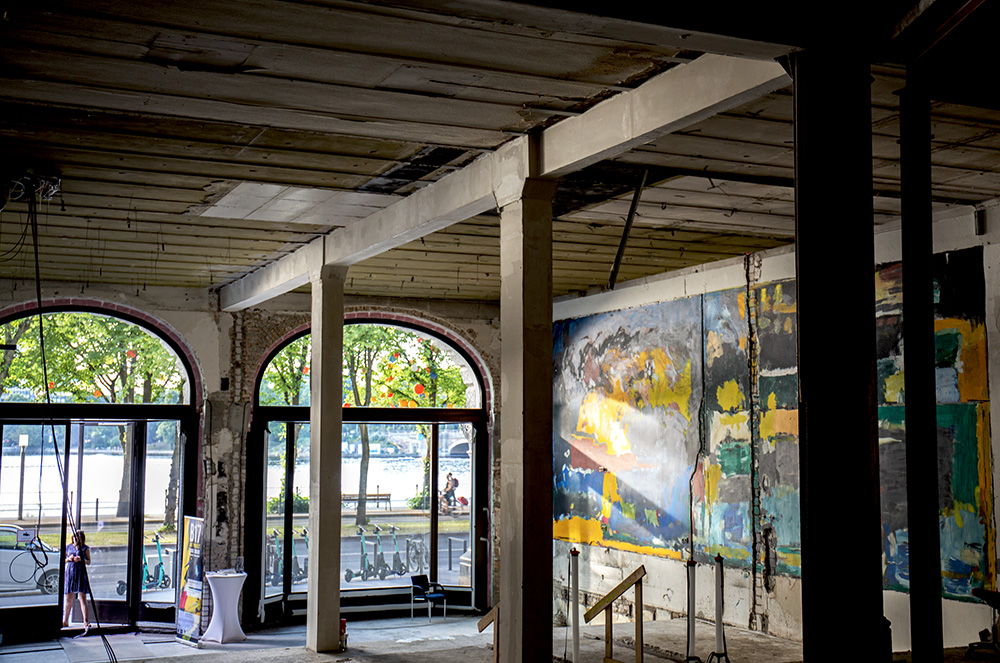What do we know about the houses we live in, the architecture we frequent, the people who once resided in them? One of the most historic buildings in Hamburg is located where the Alster used to flow: Balindamm 17. The great fire of 1842 reduced the city to rubble and ash and led to its restructuring during reconstruction: the remains of former buildings served as the foundation for the construction of a first street on the eastern bank of the Alster, on which those office buildings that shaped the cityscape later were built after the turn of the century—including the Balinhof. It was a shipowner who commissioned the architects Lundt & Kallmorgen to construct the building: Augusto Constantino de Freitas intended a representative use in addition to the professional one, so the building was planned correspondingly imposing. The end of the First World War gave the house a new owner, the Westfälische Kohlen-Kontor GmbH, which had a staggered floor and a group of sculptures added. Hardly destroyed in the Second World War, the Balinhiof is now a listed building. It is not only the stylistic elements of the building that are eclectic, but also its use over the decades.
The current renovation of the Balinhof takes this history into account: not only in the preservation of the architectural and art-historical specifics, but also through the art project of the Hamburg conceptual artist Shuk Orani. On more than 12 meters of wall space in the interior of the ground floor, the artist reminds us of what existed before in this area, the buildings former use and conversion, as well as the memory of those who lived and worked here. “We cast a shadow on something wherever we stand” is how E.M.Forster once put it: Shuk Orani traces the shadows that were cast here and lets them resurrect in abstraction. His painting symbolizes an absence and at the same time a presence: the presence of what took place in these spaces. The work of art itself is part of the transformation process that Balindamm 17 went through the Säkula: Shuk Orani’s image carrier is the wall, rough, structured by what it previously contained. The artist transfers it into the present, with an expressionistic gesture, space-filling in the literal sense. It is his specific color surfaces that generate a narrative that is contemporary and at the same time timeless, as if it were part of this world and yet not, as if the individual fragments were reminiscent of the building blocks of our childhood, which in one gradation always have their other option included. This work will also be a stage in the big picture, an interaction, even an intervention. The art changes the building and the view of those who look at it, and yet this change of perspective will also be temporary, since the work is to be sealed after the renovation. Then it is still there and yet not, imaginable, perceptible, revealable, but no longer immediately obvious—like the steps of those who walked through Balindamm 17 before of us.
For more information, please visit ShukOrani.com and follow on Instagram @shuk_orani.


Artist Statement
“Mich beschäftigen vor allem Herkunftsfragen, Fragen von Machtordnungen, die Bedrängnis und Begrenztheit durch Systemstrukturen evozieren. Im Hinblick auf das Bedürfnis nach übergeordneten und transzendenten Synergien, untersuche ich innerhalb meiner Arbeit, wie der Schutz der Natur gelingen kann. Interessant dabei ist für mich, ihre scheinbar vollkommen andere Funktionsweise, sowie Überlebensstrategien im Vergleich zu denen des Menschen.
“Meine Kritik richtet sich an den Menschen, welcher in seiner Desorientierung nur eine mangelnde Bereitschaft zum Denken größerer Zusammenhänge zeigt, da er weder seine Gefühle abrufen kann, noch in Berührung mit seiner Intuition ist. Von der Vorstellung ausgehend, dass dieser wachsende Mangel eine drohende Reduktion der Realität bewirkt, untersuche ich als Künstler, inwiefern die farbige Materie eine, zunächst defiziente, Struktur verändern und neue Wahrnehmungsmöglichkeiten schaffen kann.
“I am primarily concerned with questions of origin, questions of power systems that evoke distress and limitation through system structures.
“With regard to the need for superordinate and transcendent synergies, I investigate within my work how the protection of nature can succeed. What is interesting for me is their seemingly completely different functioning, as well as survival strategies compared to those of humans.
“My criticism is aimed at people who, in their disorientation, show an unwillingness to think about larger contexts, since they can neither call up their feelings nor are they in contact with their intuition. Starting from the idea that this growing deficiency causes a threatening reduction of reality, I as an artist investigate to what extent the colored.”






